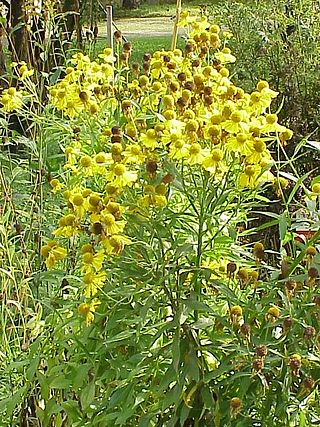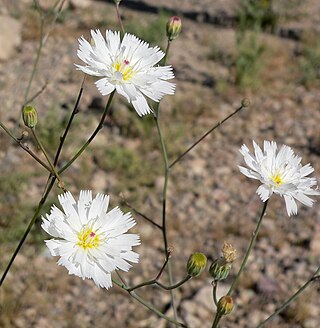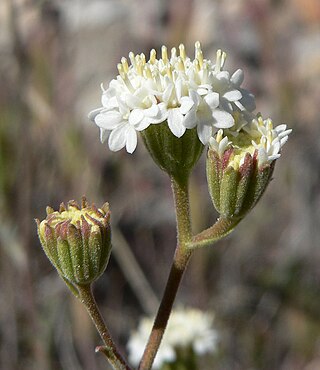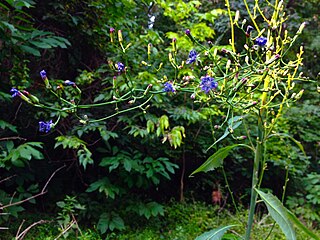
Bellis perennis, the daisy, is a European species of the family Asteraceae, often considered the archetypal species of the name daisy. To distinguish this species from other plants known as daisies, it is sometimes qualified as common daisy, lawn daisy or English daisy.

Arnoglossum atriplicifolium, the pale Indian plantain, is a perennial herbaceous wildflower in the sunflower family (Asteraceae). native to the central and eastern United States. It can reach heights of up to 3 metres (10 ft), with dramatic clusters of white flowers at the top of a central, unbranching stalk.

Mertensia virginica is a spring ephemeral plant in the Boraginaceae (borage) family with bell-shaped sky-blue flowers, native to eastern North America.

Helenium autumnale is a North American species of poisonous flowering plants in the family Asteraceae. Common names include common sneezeweed and large-flowered sneezeweed.

Echinacea simulata, commonly called wavy leaf purple coneflower, glade coneflower, or prairie purple coneflower, is a species of perennial flowering plant in the family Asteraceae. It is native to the east-central states of the United States. Its natural habitat is dry, calcareous, open areas such as barrens and woodlands.

Atrichoseris is a genus of plants in the family Asteraceae. It contains only one known species, Atrichoseris platyphylla, known by the common names tobacco weed, parachute plant, and gravel ghost.

Eupatorium altissimum, with the common names tall thoroughwort and tall boneset, is a perennial herbaceous plant in the Asteraceae family with a native range including much of the eastern and central United States and Canada. It is a tall plant found in open woods, prairies, fields, and waste areas, with white flowers that bloom in the late summer and fall.

Erigeron philadelphicus, the Philadelphia fleabane, is a species of flowering plant in the composite family (Asteraceae). Other common names include common fleabane, daisy fleabane, frost-root, marsh fleabane, poor robin's plantain, skervish, and, in the British Isles, robin's-plantain, but all of these names are shared with other species of fleabanes (Erigeron). It is native to North America and has been introduced to Eurasia.

Lasthenia californica is a species of flowering plant in the family Asteraceae known by the common name California goldfields. It is native to western North America.

Cirsium discolor, the field thistle, is a North American species of plants in the tribe Cardueae within the family Asteraceae. It is native to thirty-three states in the United States as well four Canadian provinces. It occurs across much of eastern and central Canada as well as eastern and central United States. It has been found from New Brunswick west to Saskatchewan and south as far as Texas and Georgia.

Balsamorhiza sagittata is a North American species of flowering plant in the tribe Heliantheae of the family Asteraceae known by the common name Arrowleaf Balsamroot. Also sometimes called Oregon sunflower, it is widespread across western Canada and much of the western United States.

Chaenactis stevioides, with the common names Esteve's pincushion and desert pincushion, is a species of flowering plant in the daisy family. It is also sometimes called false yarrow or broad-leaved Chaenactis.

Machaeranthera tanacetifolia is a species of flowering plant in the family Asteraceae known by the common names tansyleaf tansyaster and Tahoka daisy.
Sibara virginica is a species of flowering plant in the family Brassicaceae known by the common name Virginia winged rockcress. It is native to North America, where it can be found throughout the southeastern quadrant of the United States and in California and Baja California in the west. It grows in many types of habitat, including disturbed areas. It is an annual or biennial herb producing a basal rosette of leaves with comblike blades so deeply divided into many lobes that they may appear to have leaflets. It bolts one or more erect stems up to 30 centimeters tall. The flowers each have four spoon-shaped white petals a few millimeters long and purplish sepals. The fruit is a flattened, elongated silique up to 2.5 centimeters long containing tiny seeds.

Iris virginica, with the common name Virginia blueflag, Virginia iris, great blue flag, or southern blue flag, is a perennial species of flowering plant in the Iridaceae (iris) family, native to central and eastern North America.

Balduina uniflora is a North American species of plants in the sunflower family. It is native to the southeastern United States. It is the type species of the genus Balduina.

Erigeron speciosus is a widespread North American species of flowering plants in the family Asteraceae known by the common names aspen fleabane, garden fleabane, and showy fleabane.

Lactuca floridana, commonly known as woodland lettuce, Florida lettuce, or false lettuce is a North American species of wild lettuce. It is native across much of central Canada and the eastern and central United States.

Verbesina helianthoides, commonly called yellow crownbeard or gravelweed, is a species of flowering plant in the family Asteraceae. It is native to the United States, where it is primarily found in the Upper South and South Central areas. Its natural habitat is in communities that receive ample sunlight, such as open woodlands, prairies, and glades.

Verbesina alternifolia is a species of flowering plant in the family Asteraceae. It is commonly known as wingstem or yellow ironweed. It is native to North America.




















